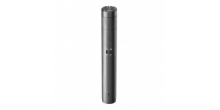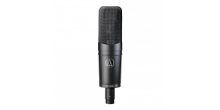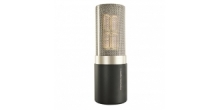 Agrandir l'image
Agrandir l'image
| Polar patterns | omni, cardioid, figure 8 |
| Acoustical operating principle | Pressure gradient transducer |
| Frequency range | 40 ... 18000 Hz |
| Switch position "reduced bass roll-off" at 90 Hz | - 10 dB ± 1 dB |
| Sensitivity at 1 kHz | 7/13/8 mV/Pa ± 3 dB |
| Rated impedance | 150 Ω |
| Equivalent loudness level due to inherent noise | |
| CCIR 468-4 | 22 dB |
| DIN EN 60651 | 14 dB - A |
| Signal-to-noise-ratio (re. 1 Pa at 1 kHz) | |
| CCIR-weighted | 72 dB |
| A-weighted | 80 dB |
| Max. SPL for THD ≤ 0,5 % | 139/134/139 dB |
| with 10 dB preattenuation | 149/144/149 dB |
| Total dynamic range of the microphone amplifier | 120 dB |
| Current consumption (P 48, DIN 45596, IEC 268-15) | 3 mA |
| Output connector | 3-pin XLR-connector goldplated contacts |
| Weight | 290 g |
| Dimensions (L x Ø) | 217 mm x 42/21 mm |
MICR3093D6
Nouveau
Microtech - UMT 70 S

The UMT 70 S condenser microphone equipped with our proven large diameter membrane capsule features outstanding performance, a high sensitivity and a improved signal-to-noise ratio. The UMT 70 S guarantees a particularly clean and colourIess sound reproduction. lt is well suited for instrumental and vocal soloists in radio and television broadcasting and for accurate productions. The pressure gradient transducer is a dual capacitor design using a single brass back plate and two large diameter gold plated plastic membranes.
Varying the polarization voltage applied to the membranes produces three directional characteristics: omni, cardioid and figure 8. A ring at the bottom of the microphone's head grill selects the pattern. The omni-directional pattern shows a slight 2 dB rise in the vicinity of 10,5 kHz while the bass response is perfectly flat. The cardioid and figure 8 patterns exhibit a smooth treble boost rising which peaks at about 4dB in the range of 7 kHz. This response coupled with a slight roll-off at low frequencies, is responsible for the legendary "presence" of this microphone. The direction of maximum sensitivity is radial to the grill, i.e. side addressed.
The newly developed transformerless circuit design substitutes the previous transformer by a symmetrical output stage yielding superb transient response combined with high RFI rejection. The circuitry also achieves wider dynamic range by lowering. The self noise floor and increasing the headroom for loud signals. A 10 dB attenuator is installed to reduce the sensitivity of the microphone when placed near extremely loud sound sources. And, a low frequency roll-off switch will reduce the proximity effect when dose miking with the cardioid or figure 8 patterns.
The microphone is equipped with a 3-pin XLR connector fitting to a microphone cable, e.g. C 70.The UMT 7O S uses 48 volt phantom powering according to the international standards DIN 45596 and IEC 268-15. lt s available in a black matte or satin nickel finish.
Features And Specs
| Polar patterns | omni, cardioid, figure 8 |
| Acoustical operating principle | Pressure gradient transducer |
| Frequency range | 40 ... 18000 Hz |
| Switch position "reduced bass roll-off" at 90 Hz | - 10 dB ± 1 dB |
| Sensitivity at 1 kHz | 7/13/8 mV/Pa ± 3 dB |
| Rated impedance | 150 Ω |
| Equivalent loudness level due to inherent noise | |
| CCIR 468-4 | 22 dB |
| DIN EN 60651 | 14 dB - A |
| Signal-to-noise-ratio (re. 1 Pa at 1 kHz) | |
| CCIR-weighted | 72 dB |
| A-weighted | 80 dB |
| Max. SPL for THD ≤ 0,5 % | 139/134/139 dB |
| with 10 dB preattenuation | 149/144/149 dB |
| Total dynamic range of the microphone amplifier | 120 dB |
| Current consumption (P 48, DIN 45596, IEC 268-15) | 3 mA |
| Output connector | 3-pin XLR-connector goldplated contacts |
| Weight | 290 g |
| Dimensions (L x Ø) | 217 mm x 42/21 mm |

































